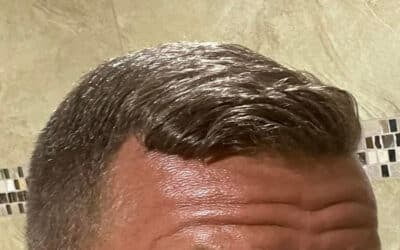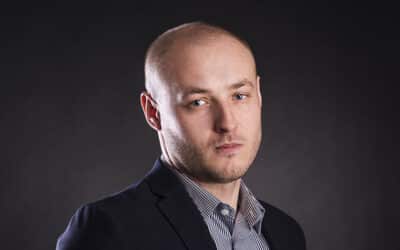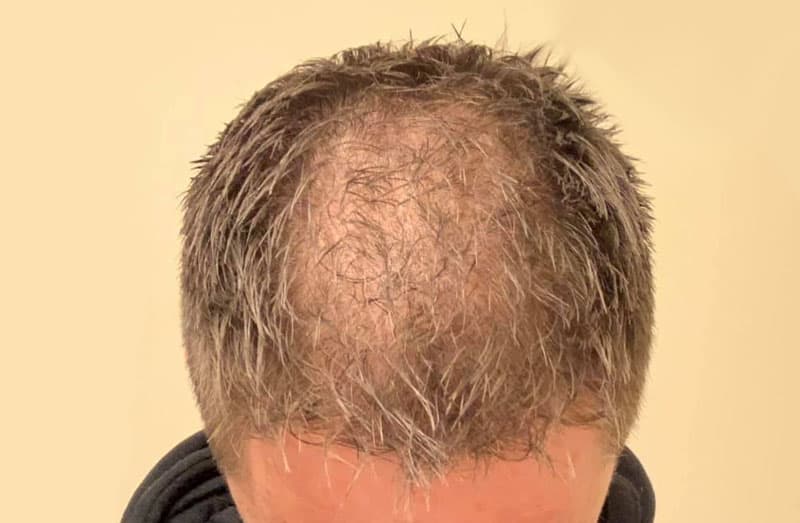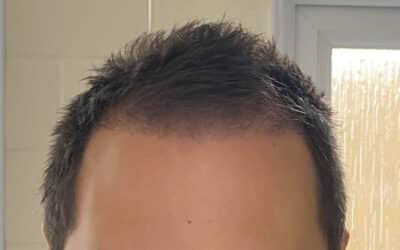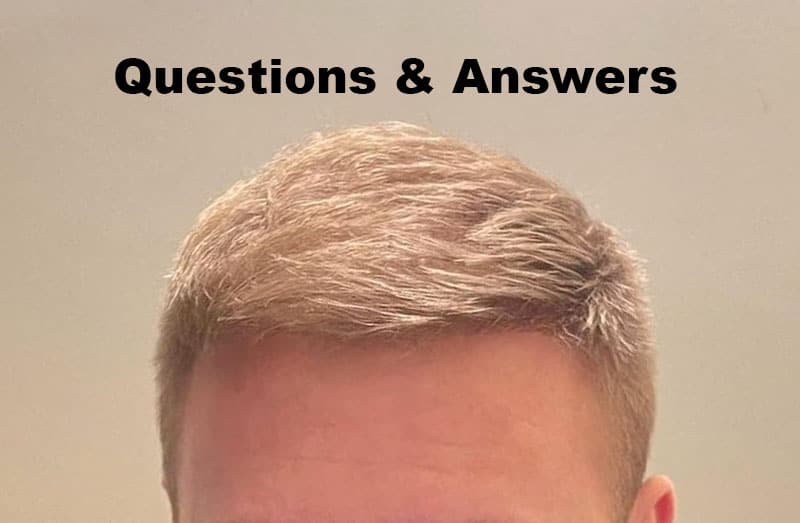Alopecia areata is an autoimmune disorder that can often result in unpredictable hair loss. And if you’ve heard of hair transplants, you may be wondering if a hair transplant can cure alopecia areata. Or at least help out. Well, the short answer is no. While hair transplants are an effective treatment for many causes of hair loss, unfortunately, they will not cure alopecia areata. In this article, we will discuss the causes of alopecia areata and potential treatments.
What is Alopecia Areata
In most cases, people with alopecia areata experience hair loss in small patches about the size of a quarter. Frequently, this occurs in just a few patches. However, in some extreme cases, it can lead to complete loss of hair on the scalp (Alopecia Totalis) or the entire body (Alopecia Universalis). This condition can happen to people of any age or gender, although most cases occur before the age of 30. There is likely a genetic component. One in five people with alopecia areata also has a family member who has experienced the same condition.
Alopecia areata will usually develop suddenly, over the course of just a few days. There’s very little evidence stress causes alopecia areata. On the other hand, stress can be a contributor to other types of hair loss. With alopecia areata, hair loss triggers because white blood cells attack the cells in the hair follicles. This may cause them to shrink and dramatically slow down hair production. We still don’t know exactly what causes the body’s immune system to target hair follicles in this manner. Curiously, some people will also often experience a spontaneous, full recovery, without the need for any type of treatment. But not everyone. Currently, there is no known way to cure alopecia areata.
Some have compared alopecia areata with vitiligo, another autoimmune disease that impacts the skin. The body attacks melanin-producing cells, which leads to white patches. Research suggests that these two conditions may share similar pathogenesis, with similarities in the immune cells and cytokines acting as the driving forces behind the disease. Plus these two conditions share genetic risk factors.
Treatment Options for Alopecia Areata
There are several treatments that have proved to be promising for regrowing lost hair. The most common treatment for alopecia areata is corticosteroids which are powerful anti-inflammatory drugs that suppress the immune system. We administer these through local injections, topically applied ointments, or oral medication. While it does not necessarily cure alopecia areata, it is a valuable tool for those afflicted by it.
Minoxidil
Minoxidil, also known by the brand name Rogain, may promote hair growth. It is a topical treatment that comes in the form of either a foam or a spray. It is available commercially in either 2% or 5% concentrations. Rogaine can help regrow lost hair and prevent further hair growth. For alopecia areata, minoxidil can be a helpful part of a treatment plan. However, it is usually insufficient to address the issues all on its own.
There are studies that date back to the 1980s that show that minoxidil is beneficial to patients with alopecia areata. Used in combination with other recommended treatments such as the use of steroids as mentioned above. While it is true that in order to treat androgenic alopecia (male or female pattern balding) one must use minoxidil consistently, or they will start to lose their hair again, this rule does not necessarily apply to those with alopecia areata. Once the hair has started to regrow, most patients can stop using minoxidil, but keep their hair. This is not the case with standard hair loss.
Understanding “Off Label” Use
It’s important to note that using Rogaine to treat alopecia areata is considered to be “off label” use. In other words, it is not approved to cure Alopecia Areata. This is because minoxidil is only FDA-approved to treat genetic hair loss and is not approved for alopecia areata. It would be illegal for the makers of Rogaine to list claims on their labels that this product treats alopecia areata. However, it is a common, legal practice for doctors to do so.
Many physicians still recommend this medication to their patients with alopecia areata though, because they feel it is helpful when used in combination with other medications. Sometimes patients with alopecia areata who say their hair fall out is getting worse, may worry that the minoxidil is to blame. However, the minoxidil is not what’s to blame. Rather it is the progression of the disease. It may be a sign that the patient is in need of more aggressive treatment.
Anthralin
Anthralin is another medication that can treat Alopecia Areata. This substance is a man-made version of a natural substance found in goa powder from the araroba trees. The medication works by slowing down the growth of skin cells. It can also treat psoriasis. Anthralin comes in the form of both an ointment and a cream. It comes in concentrations ranging from 0.2% to 1 %. In rare instances, doctors prescribe concentrations as strong as 2%. Usually, a patient applies the treatment for a few minutes before rinsing off. Over time, the duration of time that anthralin is left on the scalp is gradually increased. This treatment is sometimes used in combination with minoxidil. Anthralin may improve hair growth for patients with alopecia totalis about 50% of the time. However, saying it will cure Alopecia Areata is not accurate.
Additionally, this medication has several side effects. It has a tendency to temporarily stain the skin a yellow-brown color. It can also permanently stain clothing and fabric. In order to prevent stains, patients are advised to apply the medication while wearing plastic gloves and to wear old clothing that they aren’t concerned with ruining.
Anthralin may also cause burning and irritation, especially if applied to skin not affected by alopecia areata. Furthermore, this med may cause enlargement of the lymph nodes in the neck. It can also cause blisters and severe itching. You should stop using anthralin if the itching and blistering become severe. Interestingly, some amount of redness, scaling, and itching is a good sign that the medication is working correctly, and will support the conditions that will allow new hair to grow.
SADBE
SADBE is a liquid chemical that is applied to the scalp. The dosage starts at a 2% solution which is applied to the affected area of the scalp. It is worn for several hours and should be washed out at the end of the day. While SADBE is being worn on the skin, the scalp should be protected from sunlight. The patient waits two weeks before the second treatment is applied, this time at 0.001% solution.
A week later the patient returns and if there has been any itching or irritation from the previous dose. If they haven’t experienced any irritation, the dose is increased to 0.005%. If there was significant itching, then the dose stays the same, or may even be lowered. It is normal to experience some itchiness on the day of treatment and the day immediately following. However, it should not be extreme or persist beyond 2 days.
SADBE and topical steroids don’t mix. However, 2% or 5% Minoxidil Solution. It can sometimes be used with other non-steroid medications. You should discuss with your doctor which treatments are most appropriate for you to combine with SADBE. Typically, you see hair growth about 12 weeks after starting treatment, although some patients report that it occurs earlier. White-colored hair may appear first before darker hair follows.
Potential Side Effects of SADBE Use
Possible side effects from SADBE are very similar to what you’d experience if you had poison ivy. Negative reactions to the medicine may include:
- Rash on the scalp
- Swollen lymph nodes in the neck (usually not serious)
- Full-body rash if the medication reaches beyond the affected area
- Blisters on the scalp or body
- Changes to pigmentation of the scalp, with some areas growing lighter while others grow darker.
Additionally, please note that neither minoxidil nor SADBE is safe to use while pregnant or breastfeeding. You should stop taking SADBE and get medical help immediately if you develop hives, experience shortness of breath, swelling of the lips, or feel unwell.
DPCP
Topical diphencyprone (DPCP) is an immunotherapy tool for advanced alopecia areata prevention. A study of 41 patients with alopecia areata revealed that 40% of the patients experienced significant hair regrowth after 6 months, and out of that group, two-thirds of them retained their hair after a 12-month period. However, there are still questions about the findings’ legitimacy and currently not FDA approved.
DPCP triggers an immune response thought to oppose the action of the autoreactive cells that contribute to hair loss. If theories are correct, the body responds to DPCP treatment by attempting to downregulate inflammation through a variety of pathways. This results in a downregulation of the autoimmune response at the hair follicle, protecting the hair follicles from the destruction that would normally occur due to the flare-up in the immune system.
The preliminary research conducted on animals shows that quercetin, a naturally occurring bioflavonoid found in fruits and vegetables, can protect against the development of alopecia areata. However, to confirm the results, we need to perform further research. First, we must complete human clinical trials to study the results and consequences. Will quercetin become a reliable treatment for alopecia areata? Only time will tell.
Common Natural Treatments
Other natural treatments touted as effective treatments for alopecia areata include rubbing onion or garlic juice on the affected area. Applying cooled green tea, almond oil, rosemary oil, honey or coconut milk to the scalp may help as well. None of these are likely to have any undesirable side effects. However, documented research does not yet support claims of effectiveness.
Acupuncture Treatment For Alopecia Areata
Interestingly, acupuncture can treat alopecia areata. There is some research that concluded that acupuncture combined with the Chinese herbal formula Huoxue Shengfa is safe and effective for alleviating alopecia areata. In a recent study 31 outpatients in a treatment group comprised of 16 male and 15 female patients ranging in age from 18 to 40, who had an average duration of symptoms of approximately seven and a half months.
Both groups received 7-star acupuncture twice per week at the hair loss areas, moving from the outer edge of each patch of alopecia areata to the center in a clockwise direction. The patients in the treatment group also orally consumed the Huoxue Shengfa decoction 3 times per day. The treatment period was 4 weeks. After 12 weeks and 3 treatments in both groups, they documented the results.
Researchers documented a total recovery rate for the treatment group was an astounding 90.32% with a recurrence rate of just 9.68%. The total recovery rate of the control group was only 67.74% with a recurrence rate of 32.36%. Some patients experienced mild dizziness. Acupuncture promotes circulation to the skin. As the blood flow increases, nutrient levels in the skin replenish. This encourages increased hair growth. Additional research demonstrates that acupuncture regulates the neuroendocrine system and benefits the immune system.
Living With Alopecia Areata
About 30 percent of people living with alopecia areata report that their condition either becomes more extensive over time or they experience a continuous cycle of hair loss and regrowth. About half of the people recover from it within a year’s time. However, many others experience more than one occurrence of sudden hair fallout. Others may deal with it for the rest of their lives.
This condition can also affect the fingernails and toenails. Sometimes, fingernails show the earliest signs of alopecia. These include the sudden appearance of pinpoint dents, white spots or lines, or sudden changes to the texture of the nail such as a rough texture, loss of shine, or the nails will become thin and split.
Hair Transplants Will Not Cure Alopecia Areata
Hair transplant surgery is not a suitable treatment option for alopecia areata. It’s unfortunate but true. That’s because it does not address the root causes of immune system malfunction. Typically, we divide hair transplants into two types of procedures. Follicular Unit Transplantation (FUT) and Follicular Unit Extraction (FUE). In both procedures, doctors remove the grafts of the hair follicles from the back of the head. Then, your doctor transplants them into the affected area experiencing hair loss.
However, alopecia areata is a recurring immune condition. It is different from common male or female pattern baldness. It is not the same as common hair thinning. In other words, there’s no guarantee that newly transplanted hair follicles would not become vulnerable to attack by the body’s immune system. For this reason, we don’t recommend hair transplant surgery for alopecia areata patients. However, as we’ve shown, there are options. Please consult your doctor for more info and good luck in your fight to regain your hair.
References:
- https://www.medicalnewstoday.com/articles/70956#diagnosis
- https://www.healthcmi.com/Acupuncture-Continuing-Education-News/1503-acupuncture-and-herbs-regenerate-hair-for-alopecia-areata-patients
- https://en.wikipedia.org/wiki/Diphenylcyclopropenone
- http://www.canadianhairlossfoundation.org/anthralin
- https://donovanmedical.com/hair-blog/minoxidil-aa

